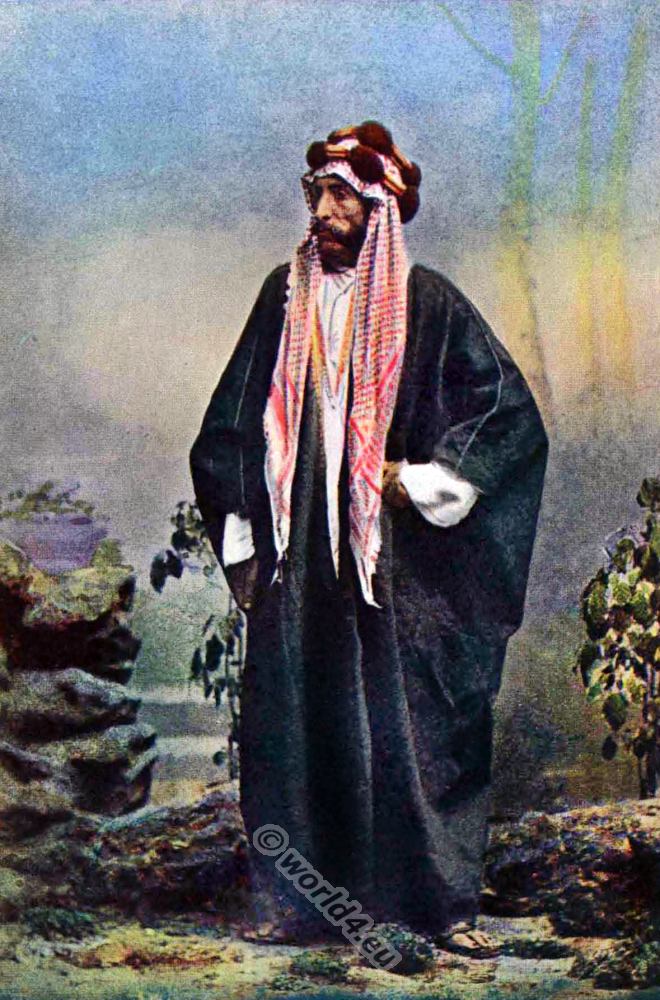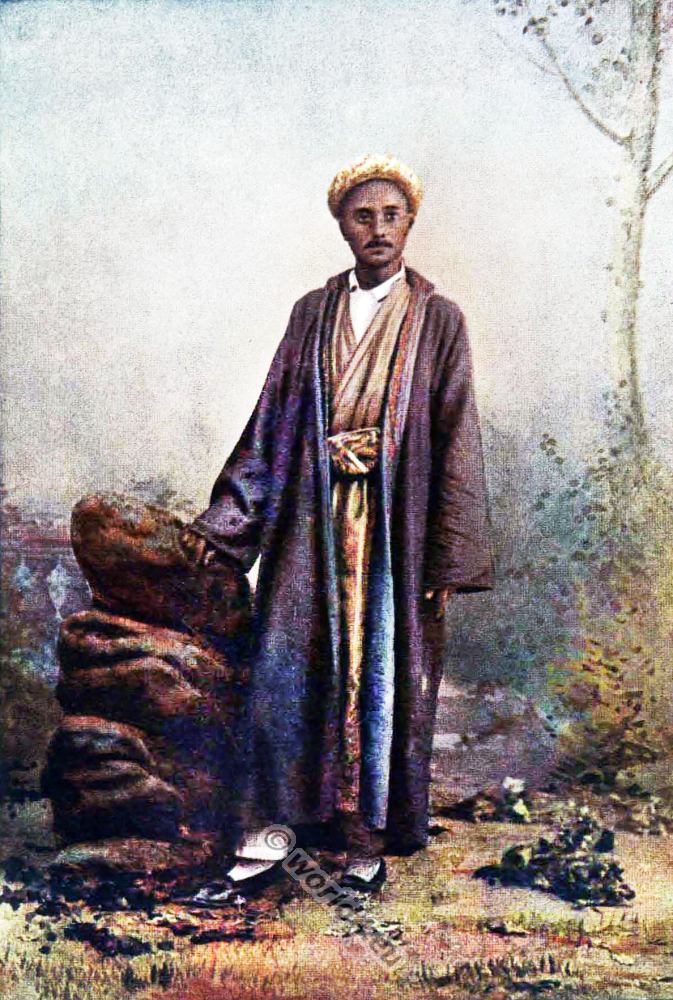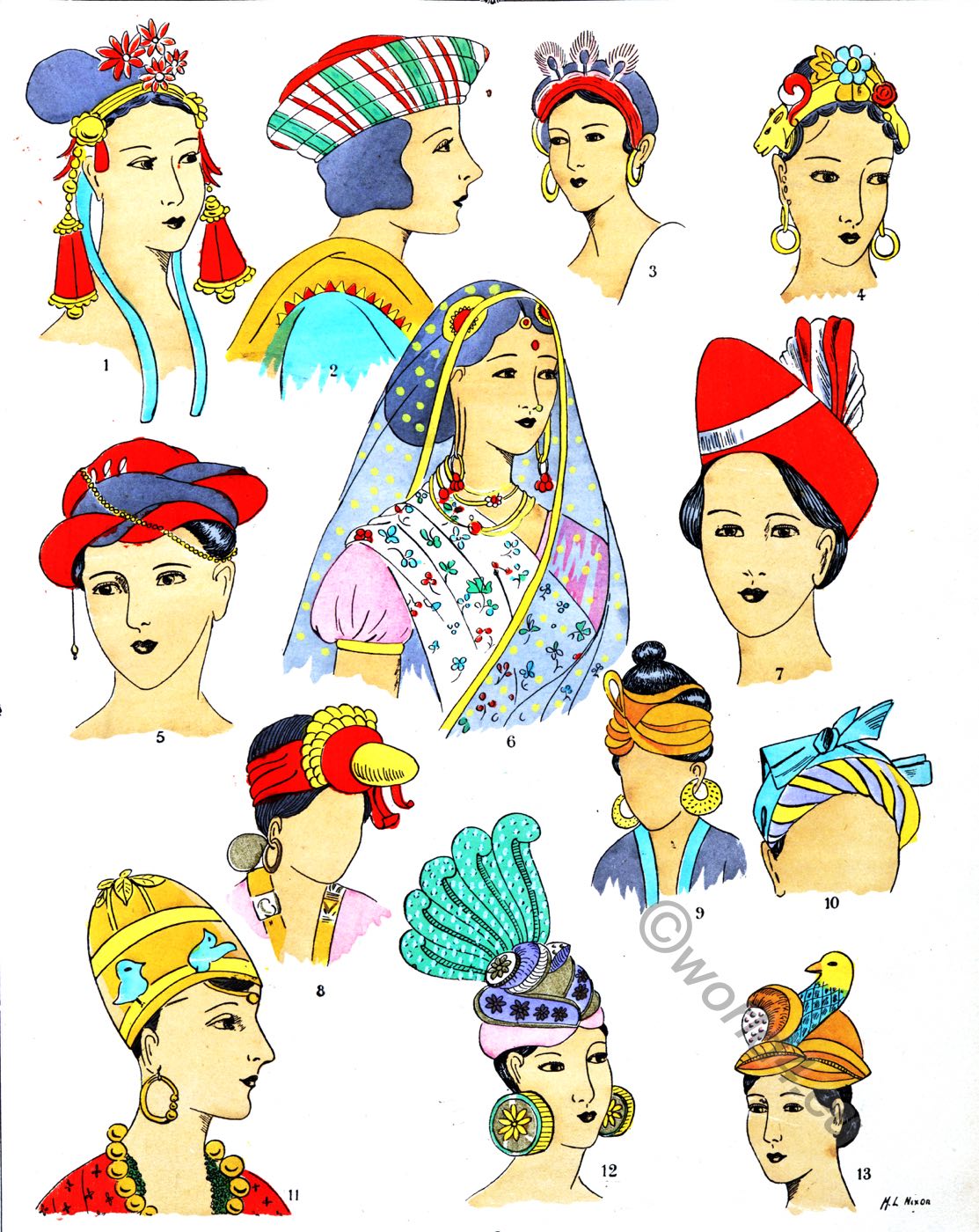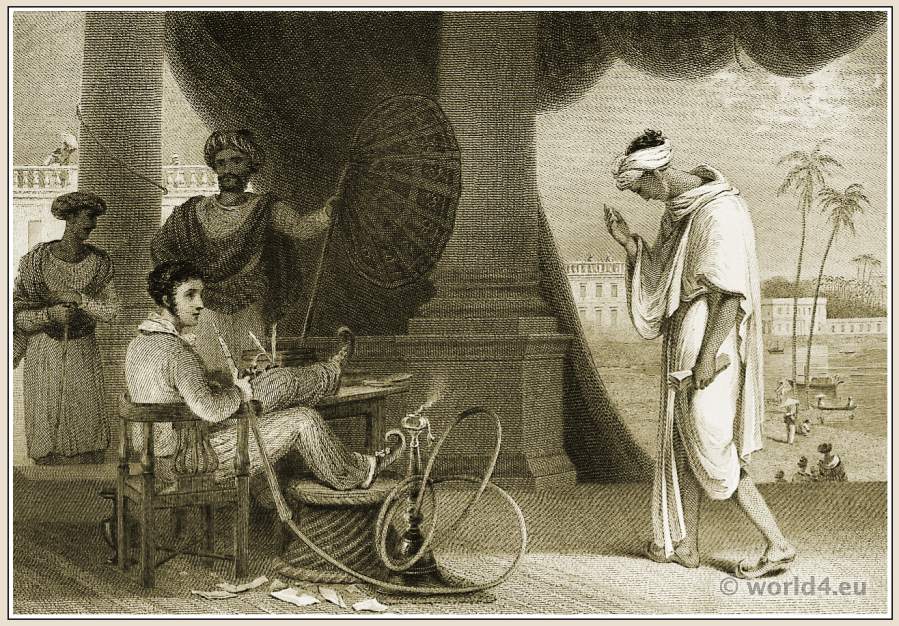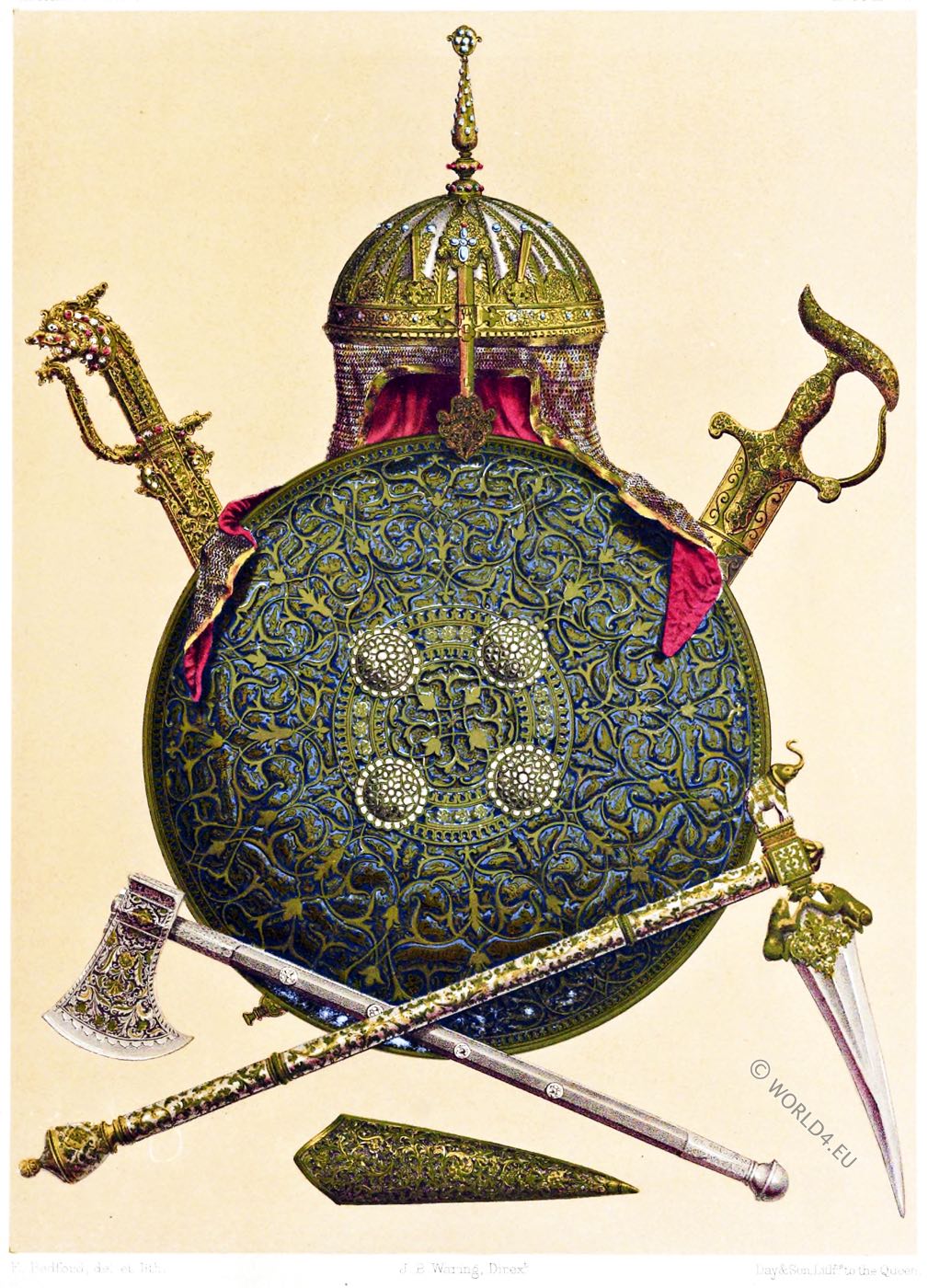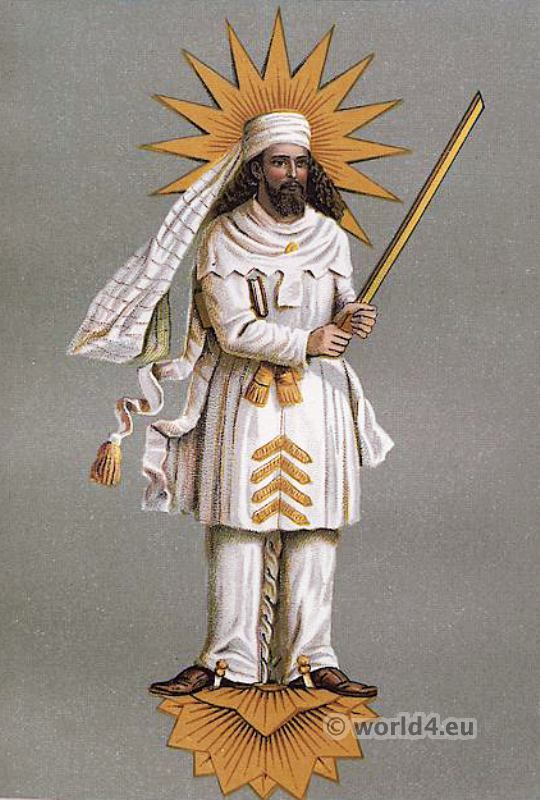India. Garments, Dresses. Principal Costumes.
The Feminine Costume of the World. Dresses. Part VII. India. Plate 3.
The Fascination of the Indian Costumes.
Description of Plate 3.
1. Costume of artisan’s wife (parsee). White tunic with red border, cast over the shoulder, and one flap caught in the belt.
2. Dancing Bayadeer. The transparent dress lets the body be seen. Little bolero above the breast.
3. Bayadeer nautch dancing. Draped gown with flowerets and red border.
4. Woman of Vilnour, near Puducherry (Pondichery), listening to street-preacher. Broadly draped gown, striped green on yellow and folded over one shoulder. Little bolero on the chest.
5. Costume worn by a women hunting, draped gown.
6. Costume of lower-class woman in Bombay. Veil on head, short trousers.
7. Southern Deccan woman. Smock caught long trousers.
8. Singalese woman’s gown. Scarfs with blue and white stripes.
9. Costume worn by the wife of a tatcheu or carpenter, going to sell wooden caskets in bazaars. Draped gown.
10. Otten woman (nomad tribe) carrying her child wrapped in a flap of her gown. White gown with red embroidery.
Principal Costumes.
TUNIC.
The tunic of Indian women probably reached to the hips, or, if wrapping the upper part of the body, was sleeveless.
The women wore, and still do wear, instead of a tunic, a piece of lined draped three or four times round the waist, covering the shoulders and head like a shawl, then falling down to the breast. Some, however, are naked from the waist up to the head.
CORSELET.
Along the Orissa (Odisha) coast they wear a little corselet whose sleeves reach only to the elbows, fastened at the back, wound round the upper part of the chest, and leaving the body bare down to the waist.
Indian women, being very fond of ornaments, load their arms and legs with golden rings, as well as their forehead, hair, and one side of their nose.
Broad trousers covered with a shirt and a waist-garment draped on the bosom, head and shoulders, constitute their habitual costume.
Instead of the light waist-garment displaying half-naked forms, some regions have loose gowns embroidered with gold and silver. The lower garment is very wide, swelling out in dancing like a balloon and covering tight pants that fall down to the ankles.
In summer the women wear huge waist-garments of dotted linen leaving one breast and part of the stomach uncovered.
These women carry their children in the draped part of their waist-garment, left loose from the shoulder to the belted waist.
KING.
The magnificent luxury of Indian Kings surpassed the greatest splendor of all other nations. When the king showed himself in public, his officers, carrying silver censers, perfumed every path he was to tread. He used to lie on a golden litter hung all round with pearls, and behind which walked armed men and body-guards, carrying, on tree-branches, birds which had been trained to divert him with their singing from serious
business.
The scene pictured on our cover-page represents one of the Indian princesses, or Ranis, as they are called in Malabar (Kerala), of the royal family of Travancore (Indian kingdom from 1729 until 1949).
This Sanscrit word does not mean “Queen”, for the rajahs in that country have but concubines. Only the mother and sisters of the reigning prince are entitled to the name of Rani or Rajni.
The prince’s sisters live exclusively in the palace and never marry. They belong by right to the brahmins, and the sons to whom they give birth accede to the throne in rank of primogeniture, to the exclusion of the king’s children.
CUSTOMS.
When betrothed, the mongol maiden wears on her head a broadly frilled coif similar to a crown, on account of the frills resembling battlements. She also wears a sort of apron with which the husband is bound to present his wife. It is always of rich texture, and even among the poor it is made of silk.
THE DOLI.
The “doli”, or rich woman’s palanquin is generally covered all over with white or red stuff; it is provided, in front and behind, with a thick shaft holding the body. This palanquin, rather high and less broad than a carriage, is long enough for one to lie down in, as if in bed, on the rush mat covering the bottom. To lift it up, the two front bearers place between them the foremost pole, which one of them holds on the right shoulder and the other on the left; the two rear bearers do the same.
VISITING.
Indian women if they have some claim to rank or wealth, never venture out but in a “doli” and enter it strictly veiled.
Women of the highest castes have a numerous train to carry the “kouka”, betel or perfumes.
A “mayah” or governess generally keeps by the side of the palanquin so as to receive orders. This servant is simply clad in a straight skirt and “choli”, a small jacket with short sleeves. A sari with a broad red border wraps up the head, is draped on the shoulders, and falls in a wide flap in front of the gown. She also wears a nose-ring; her bracelets are of varnished wood.
GUILDS.
The Hindu has no other tribe than his caste, a closed world out of which he cannot marry. Castes proceed no less from trade than from race; when the profession differs which is the usual case in the greater part of the peninsula – each particular group stands isolated as if wishing to raise round itself a brazen wall.
NOSE.
In Malabar (Kerala) the nostril is bored from infancy. At three or four years of age, a little girl already wears a thorn or a sprig of bamboo to prevent the hole from being stopped up, until, when grown to womanhood, her fiancé replaces the thorn by a sapphire or ruby which will for ever be “beneath her eye”, and as near it as possible as a reminder of love.
In one of our plates, the bright black hair of a jewel-woman is set off by a small embroidered silk skull-cap daintily worn on the side of the head. The back hair is braided rather low down. Her graceful costume consists of a skirt and a ” sari” of the same material, which later article is kept up loin-high by a cashmere sash.
DANCES.
The “Nautch” or bayadeers dances are one of the rich people’s favorite diversions and the necessary accompaniment to every festival.
In their performances, the bayadeers generally begin by a dance in which they do nothing but whirl round with arms outstretched; then the veil waves out, the “kangra” swells and spreads out fully; the small bells on the bracelets mark time; they come thus, one after another, to wheel round before the host and guests.
At a given moment, the dancers lay aside their “cholis” and muslin gowns: their busts appear naked. Then, through skillful gradation, the traditional phases of a nautch take place, when the women’s beauty, their graceful motions, the twinkling of their jewels cleverly combine for the gratification of the eyes.
COLOR.
If red predominates in these costumes, it is because this color, in India, is emblematic of joy and merriment, in opposition to black which is ominous. In weddings and other ceremonies red is indispensable in garments; the invitation-cards are of red paper.
BETEL.
Indian women are always provided with betel. They cleverly manage to send the most risky messages by means of various cuts in the leaves, the meaning of which is known to them only.
Religion makes it a duty for women to wear a small black star-shaped sign on the chin, another on one side of the nose, a third one between the eyebrows. Their hair, made glossy by moistening it with cocoa-nut oil, is tied up behind in a mass, or braided in long tresses, as worn by dancers. (Only women in mourning, or punished for some offence, have their heads shaven.) The hair is parted on the forehead by a small bunch of pearls or precious stones, in the middle of which a larger one is observable.
NOSE.
A Hindu custom is the nose-rlnq, and women even in the humblest condition often wear a golden one enriched with pearls; the “sounk” or shell bracelets have the same character.
TOBACCO.
Individuals of every class and of both sexes smoke tobacco and chew betel. The law of Manu (Manusmriti or mānavadharmashāstra) forbidding women the use of the pipe is the least observed. They smoke even in public.
FACE-PAINTS.
A mixture of Arek nut and lime spread on a leaf of betel-pepper dyes the lips and tongue red; its effect is noxious to the teeth which become ebony-black, but Indian women are persuaded that this color is becoming and scoff at Europeans “whose teeth are white like dogs’ and apes'”.
HEAD-DRESS.
Women of servile condition usually carry every possible load on their heads, vases among others. This is incompatible with the adornment of hair, so that, to carry either a broad-bellied vessel or a huge parcel, an Indian lady will use her thin scarf, or maybe her veil, by arranging it on her left shoulder into a ring or suspension-hook.
COTTON-CAMBRIC.
“Nothing”, says Jacquemont, “is so shabby as the native costume when made of English cotton cambric; nothing is so dainty as the same when made of muslin. Yet, in the crowd, and from a distance the whole often looks very dirty and ragged, very unpicturesque in details but sometimes rather pleasant-looking as a whole”.
MONGOLIA.
Mongolian ladies wear veils of that smooth silky muslin, incomparably light though strong, which the Romans called “Ventus textilis” and “nebula linea”.
JEWELS.
Indian ladies wear jewels on their forehead, ears and hands; they would even wear them on their feet if they were not shod. Many of them wear a ring or pearl in their noses, and their necklaces and bracelets are enriched with precious gems.
GOWN.
The gown, leaving the arms uncovered and showing the naked bust through it, is made of thin and light Dhaka cotton; the trousers are of embroidered silk, and from Cashmere valley, the hanging gold texture, is usually fastened in front of the belt. Their shoes are slippers without heels or sides.
HEAD-DRESS.
The women wear their own hair, wigs having always been an object of repulsion to the Indians. After bathing, the Mongol ladies perfume themselves with sandal-powder which is the most usual scent. Their eyes are touched with black, by means of antimony.
BURMA.
The Burma (Myanmar) gala-dress is graceful and soft. Men and women wear about the same costume, ear-rings and jewels.
The dress consists of a flowery velvet or satin coat reaching down to the ankles, with an open collar and broad sleeves. Over this dress, the Indian women wear a light and loose piece of stuff covering only their shoulders. Their head-gear is a tall velvet cap, plain or embroidered according to the wearer’s rank.
Women usually tie their hair on the top of the head, adorning it with a band, the embroidery of which marks their rank.
SASH SCARF.
A short and broad tunic with tight sleeves covers a long piece of stuff which is wound twice round the body, girds the loins, and trails on the ground. When ladies of rank go out visiting, they wear silk sashes like long shawls crossed over the breast, and whose ends gracefully wave over the shoulders.
COTTON.
Women of the lower classes are clad in common cotton material, leaving their bodies partly uncovered.
They have preserved the fashion of tattooing the arms and legs. The mountain-folks’ garments are of thick black cotton material edged with white, red and yellow. The women’s are much longer than the men’s. The head-gear is a turban, with the addition, for women, of tassels made with the body of an insect of the beetle tribe. They wear countless necklaces and bracelets of glass-beads. Their faces are tattooed.
Women of Martalan, a province of Tje-Tavai, wear neither gold necklaces nor bracelets on their arms and legs; their favorite stuff is silk; they also wear cotton and muslin. Here again the women are tattooed.
In Hindustan, here are two main typical costumes:
A dress termed cabaille: a muslin handkerchief is tied round the waist; trousers and Moorish slippers, and a sort of cap ending in a bunch not unlike the Grecian cap.
2nd costume: White turbans quaintly pleated, or flat turbans; white muslin trousers, flowing scarfs.
The waist-garment is sometimes so very long as to serve for a skirt, sash, scarf, and hair-veil at the same time.
The bodice, when there is one, is a sort of very short and tight corselet fitting closely on the shoulders and upper arms; and frequently stopping half chest-high, leaving the breast naked or imprisoned in a gold or silk net.
SHAWL.
The sort of shawl or waist-garment depicted at the beginning of the present chapter is conceivable in a country where heat increases by degrees, and coolness comes on suddenly. The shawl neither succeeds nor pleases in Europe because it is clumsily worn.
Source: Paul Louis de Giafferri. The History of the Feminine Costume of the World. The Fascination of the Indian Costumes. Published: 1926.
Related: India. Mughal Empire. Fashion History.
Discover more from World4 Costume Culture History
Subscribe to get the latest posts sent to your email.


